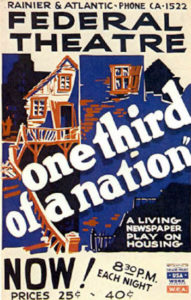
*On this date, 1935, the Federal Theatre Project (FTP) was formed. This theatre program was established during the Great Depression as part of America’s New Deal.
Referred to as part of the Second New Deal, it funded live artistic performances and entertainment programs in the United States. It was one of five Federal Project Number One projects the Works Progress Administration sponsored. It was created not as a cultural activity but as a relief measure to employ artists, writers, directors, and theater workers. It was shaped by national director Hallie Flanagan into a federation of regional theaters that created relevant art, encouraged experimentation in new forms and techniques, and made it possible for millions of Americans to see live theatre for the first time.
The Negro Theatre Unit (NTU) was part of the Federal Theatre Project and had units set up in cities throughout the United States. Capitalizing on the FTP's national network and inherent diversity of artists, the Federal Theater established specific chapters dedicated to showcasing and celebrating the work of previously underrepresented artists. Including the French Theater in Los Angeles, the German Theater in New York City, and the Negro Theatre Unit, which had several chapters across the country, with its largest office in New York City.
The NTU had additional offices in Hartford, Boston, Salem, Newark, and Philadelphia in the East; Seattle, Portland, and Los Angeles in the West; Cleveland, Detroit, Peoria, and Chicago in the Midwest; and Raleigh, Atlanta, Birmingham, and New Orleans in the South; There were additional units in San Francisco Oklahoma, Durham, Camden, and Buffalo. By the project's conclusion, 22 American cities had served as headquarters for Black theater units. The New York Negro Theatre Unit was the most well-known. Two of the four federal theaters in New York City, the Lafayette Theatre and the Negro Youth Theater, were dedicated to the Harlem community to develop unknown theatre artists.
Both theatre projects were headquartered at the Lafayette Theatre in Harlem, where some 30 plays were presented. The first was Frank H. Wilson's folk drama, Walk Together Chillun (1936), about deporting 100 African Americans from the South to the North to work for low wages. The second was Conjur' Man Dies (1936), a comedy mystery adapted by Arna Bontemps and Countee Cullen from Rudolph Fisher's novel. The most popular production was the third, which came to be called the Voodoo Macbeth (1936), director Orson Welles's adaptation of Shakespeare's play set on a mythical island suggesting the Haitian court of King Henri Christophe. The New York Negro Theatre Unit also oversaw projects from the African American Dance Unit featuring Nigerian artists displaced by the Ethiopian Crisis. These projects employed over 1,000 Black actors and directors.
The Federal Theatre Project was distinguished for its focus on racial injustice. Flanagan expressly ordered her subordinates to follow the WPA policy against racial prejudice. When making decisions on a national level for the project, it was mandated that "there may be racial representation in all national planning." A specific example of the FTP's adherence to an anti-prejudicial environment came when a white project manager in Dallas was fired for attempting to segregate Black and white theater technicians on a railroad car. Additionally, the white assistant director of the project was pulled because "he was unable to work amicably" with the Black artists. The FTP overtly sought out relationships with the African American community, including Carter Woodson of the Association for the Study of Negro Life and History, as well as Walter White of the NAACP.
One of the existing stipulations from the Works Progress Administration for employment in the FTP was prior professional theater experience. However, when encountering 40 young, jobless Black playwrights, national director Hallie Flanagan waived the WPA requirement to provide a platform and training ground for new young playwrights. During a national conference, Flanagan proposed that an African American artist lead the leadership of the Harlem chapter of the FTP. Rose McClendon, an established actor at the time, publicly argued against this proposal and instead suggested that an established white theater artist initially take the mantle to satisfy the WPA's prior professional theater experience clause and give way to Black artists to lead the chapter. This argument from McClendon received support from Edna Thomas, Harry Edwards, Carlton Moss, Abraham Hale Jr., Augusta Smith, and Dick Campbell.
This crusade for equality eventually became a sticking point for the Dies Committee, which pulled funding for the Federal Theater Project, citing that "racial equality forms a vital part of the Communist dictatorship and practices." Although the Federal Theatre project consumed only one-half of 1% of the allocated budget from the WPA and was widely considered a commercial and critical success, the project became a source of heated political contention. The House Un-American Activities Committee claimed the content of the FTP's productions supported racial integration between Black and white Americans while also perpetuating an anti-capitalist communist agenda and canceled funding for the project on June 30, 1939.